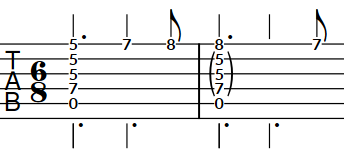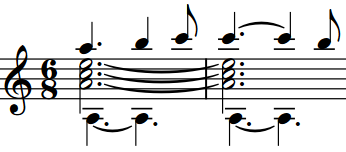Ties
A tie is a curved line that joins two notes of the same pitch. When notes are longer than the maximum duration of a bar in the prevailing time signature, they automatically appear in Dorico Pro as tie chains; that is, a sequence of adjacent notes joined with ties.
Each sequence of ties, whether they join two notes or ten notes together, represents a single note with the duration of all the tied notes combined. A performer plays the notes as one note, without re-striking, re-blowing, or re-bowing the note at any point within the rhythmic duration of the tie chain.

On tablature, ties are automatically notated as round brackets around notes/chords in subsequent bars. When tablature is shown with rhythms, ties within the same bar are indicated with stems rather than bracketed noteheads.

|

|
In Dorico Pro, most ties are created automatically. Rhythms are notated according to the prevailing beat grouping, which is normally set by the time signature. Therefore, notes that cannot be notated using a single duration are automatically drawn as tie chains. For example, if you input a dotted whole note at the start of a bar in a 4/4 time signature, it is automatically notated as a whole note tied to a half note in the next bar. If the time signature changes, tie chains are automatically adjusted to remain correct in the new meter.
Dorico Pro automatically determines the appropriate endpoint position and curvature direction for ties to avoid collisions, according to the context and your project-wide settings.
-
Slurs must not be confused with ties, which look superficially similar, but instead join notes of the same pitch to indicate that they are played as a single note. In that sense, ties are part of rhythmic notation, while slurs are considered articulation.
-
In Write mode, you can only select whole tie chains because Dorico Pro considers each tie chain to be a single note. Any edits you make to tie chains in Write mode affect all notes in them, such as changing the pitch, but only affect the first tie in the chain, such as changing the tie style to dashed. However, you can still input notations, such as dynamics, in the middle of tie chains by activating the caret and moving it to the required rhythmic position within the tie chain.
In Engrave mode, you can select individual notes and ties within tie chains and edit them independently.
-
When you tie existing notes together, they might be consolidated into fewer or more notes within a tie chain, depending on the musical context, the time signature, and the position of the start of the note in the bar.
-
Articulations can only appear once on each tie chain, either at the start or the end, depending on the type of articulation. For example, staccato marks appear at the end whereas accents appear at the start. You can change the positions of articulations relative to tie chains project-wide and for individual tie chains.